Animals and Prophecy
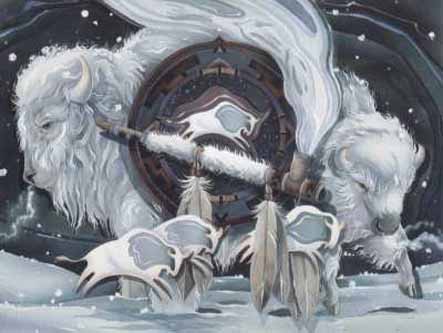
In many prophecies, the birth of rare animals represents a rebirth for humanity,
the sacred animals being harbingers of peace, as foretold by the ancients.
White Buffalo - White Buffalo Calf Woman
Third rare white buffalo born on Wis. farm Reuters - September 14, 2006
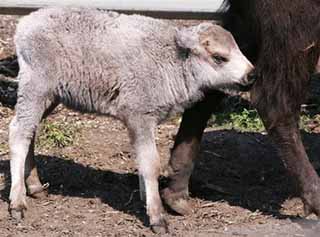
- Milwalkee: A farm in Wisconsin is quickly becoming hallowed ground for American Indians with the birth of its third white buffalo, an animal considered sacred by many tribes for its potential to bring good fortune and peace. Thousands of people stopped by Dave Heider's Janesville farm after the birth of the first white buffalo, a female named Miracle who died in 2004 at the age of 10. The second was born in 1996 but died after three days. Heider said he discovered the third white buffalo, a newborn male, after a storm in late August. Over the weekend, about 50 American Indians held a drum ceremony to honor the calf, which has yet to be named, he said.
Floyd "Looks for Buffalo" Hand, a medicine man in the Oglala Sioux Tribe in Pine Ridge, S.D., said it was fate that the white buffaloes chose one farm, which will likely become a focal point for visitors, who make offerings such as tobacco and dream catchers in the hopes of earning good fortune and peace. The white buffalo is particularly sacred to the Cheyenne, Sioux and other nomadic tribes of the Northern Plains that once relied on the buffalo for subsistence.
According to a version of the legend, a white buffalo, disguised as a woman wearing white hides, appeared to two men. One treated her with respect, and the other didn't. She turned the disrespectful man into a pile of bones, and gave the respectful one a pipe and taught his people rituals and music. She transformed into a female white buffalo calf and promised to return again.
That this latest birth is a male doesn't make it any less significant in American Indian prophecies, which say that such an animal will reunite all the races of man and restore balance to the world, Hand said. He said the buffalo's coat will change from white to black, red and yellow, the colors of the various races of man, before turning brown again.
The birth of a white male buffalo means men need to take responsibility for their families and the future of the tribe, Hand said.The odds of a white buffalo are at least 1 in a million, said Jim Matheson, assistant director of the National Bison Association. Buffalo in general have been rare for years, thought their numbers are increasing, with some 250,000 now in the U.S., he said. Many people, like Heider, choose to raise the animals for their meat, which is considered a healthier, low-fat alternative to beef. Gary Adamson, 65, of Elkhorn, who is of Choctaw and Cherokee heritage, said tribal elders will help interpret the animal's significance.
Baby buffalo believed to be good luck charm NBC - May 10, 2006
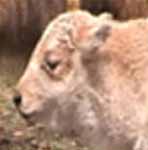
- Evergreen: It's the first white buffalo calf ever born on the ranch, which doubles as a wild game preserve. Out of 50 head, the ranch now has three white buffalos. Some Native American tribes believe the white buffalo is a sign of good things to come. The ranch purchased two white Buffalo cows from the White Elk Ranch in Gunnison last March. White buffalos can fetch up to 10 times the average price of the more common brown buffalo. The calf's father died last winter making this baby buffalo the last generation to come from the prized bull. "It's been a tough winter and it's a promise of a great summer with the calves being born, but not only the calves but a white calf," says Ronald Lewis, with Big E Game Ranch. Lewis says he still hasn't been able to get close enough to the calf, but he feels certain it's a bull, which is even more rare.
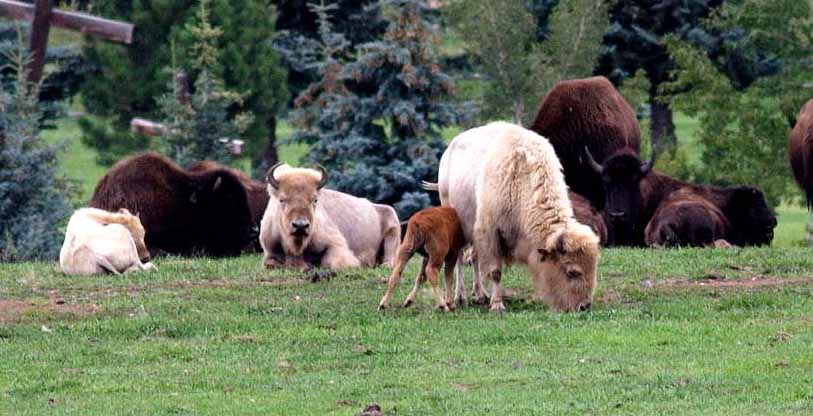
August 2006
June 8, 2005 - Kentucky: A second rare white buffalo born in 2005
White calf named Cante Pejuta, or Medicine Heart
Her mother, formerly 'cow No. 9,' is now Spirit Mother.
- This white buffalo is unique as it links to 9/11.
- albinos
- the result of crossbreeding with white cows
- temporarily white and turn dark by their first winter
When a rare white buffalo was born Friday at a buffalo ranch in Shelby County, owners Bob and Julie Allen thought the baby had prophecy written in her genes. The white calf, regarded as a sacred symbol by Lakota Sioux and other Plains Indian tribes, is a granddaughter of the ranch's former big star, award-winning bull Chief Joseph, a hefty 3,000-pound sire that had cost the Allens $101,000.
The bull was struck by lightning on Sept. 11, 2001, and died two weeks later. So the Allens, who own the Buffalo Crossing Restaurant & Family Fun Ranch, were delighted by the calf's birth. "The appearance of a white buffalo is regarded by some followers of American Indian spirituality as on par with the Christian idea of the second coming of Christ," said Bob Pickering, a researcher at the Buffalo Bill Historical Center in Cody, Wyo.
As the story goes, Lakota Sioux rituals and beliefs were brought to the tribe by a spiritual being known as the White Buffalo Calf Woman, Pickering said. A white buffalo calf is interpreted as the sacred reincarnation of the woman, he said. Historically, the white buffalo is probably about the most spiritual being on the prairie," he said. Pickering estimated the incidence of white buffalo births at about 16 per million.
He said there are three reasons white calves sometimes appear ... they may be:
"The calf is not an albino," said Julie Allen, noting that its eyes are brown, not pink. Flicking her ears and whisking her tail back and forth, the 40-to-50-pound calf resembles a lamb. "In the past, Indians sacrificed white buffalo as sacred offerings, but now they avoid doing that," Pickering said.
Rare white bison born in B.C. - CBC News - May 25, 2005
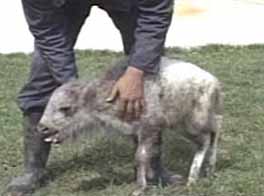
Fort St. John - A buffalo rancher near Fort St. John in northeastern B.C. is bracing for scores of visitors following the recent birth of a rare white calf. This is the first white calf that was born in Canada. Aboriginal legend holds that the white bison is a harbinger of peace and unity. And in that spirit, ranche owner, Blatz says she has named the male calf Spirit of Peace. To them a white buffalo is a symbol of hope, rebirth or unity and also peace. And because he was born north of Peace River.
White bison born near Flagstaff - May 24, 2004 - AZ Republic

The owners of a small bison herd near Flagstaff were surprised Saturday morning to find one of their rare white buffaloes had given birth to something even rarer: a white calf. "This is so rare specifically because she was born white," Davis said. "The others were born red (like normal buffaloes) and turned white. The birth of a white bison is meaningful for many Native American tribes, especially Plains Indians such as the Lakota, who consider it a symbol of rebirth when the world's people are in troubled times. The white buffalo is such a phenomenon because they are so rare. None of her buffaloes is albino but rather a mutation of the usual fur color of dark brown to black. Of 11 bison on the ranch, four are white, not including the newborn. The animals on the ranch are also pure bison, proven by DNA testing at a California lab, she added, and not a mix of bison and cattle, known as beefalo. The ranch was moved onto its 5-acre site near the San Francisco Peaks in December 2001 and has had visitors from around the globe to see white bison."
Spirit Mountain Ranch in Flagstaff, Arizona has successfully bred two generations of white buffalo starting from a single white female, all with brown fathers.
- Miracle Moon (female, born April 30, 1997)
- Rainbow Spirit (female, born June 8, 2000, calf of Miracle Moon)
- Mandela Peace Pilgrim (female, born July 18, 2001, calf of Miracle Moon)
- Arizona Spirit (male, born July 1, 2002, calf of Miracle Moon)
- Sunrise Spirit (female, born May 22, 2004, calf of Mandela Peace Pilgrim)
- Spirit Thunder (male, born May 27, 2004, calf of Rainbow Spirit)
- Chief Hiawatha (male, born May 16, 2005, calf of Miracle Moon)
In 1833, a white bison was killed by the Cheyenne. The skin of this bison is hanging on the wall of Bent's Old Fort in Colorado. The Cheyenne killed this white bison during the Leonid Meteor Shower (The Night the Stars Fell) and scribed a peace and trade treaty on its skin. This event was documented by historian Josiah Gregg and other travelers on the Santa Fe Trail.
A bison named Big Medicine (1933-1959) was born in the wild on the National Bison Range on Montana's Flathead Indian Reservation, and is now displayed at the Montana Historical Society.
A female named Miracle (not Miracle Moon), was born at the family farm of Dave, Valerie, and Corey Heider near Janesville, Wisconsin on August 20, 1994. Her fur fully transitioned to brown as she matured, and she gave birth to four calves of her own before dying of natural causes on September 19, 2004. Sioux tribal members had continually visited their farm since the birth of Miracle. Additionally, a calf born at the Heider farm died aged 4 days in 1997. A third white calf was born in September 2006.
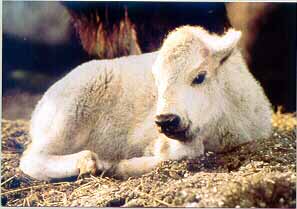
Miracle, The Sacred White Buffalo
Born August 20, 1994
Died September 19, 2004
Heider Farm - Janesville, Wisconsin
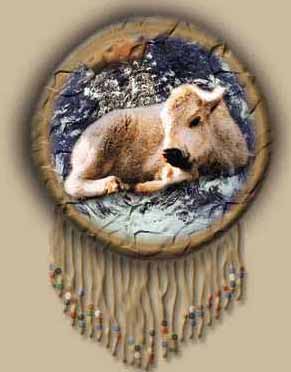
White Buffalo Wikipedia
White Buffalo Mythology
Egyptian Book of the Dead - Chapter 84
And when she promised to return again, she made some prophesies at that time. One of those prophesies was that the birth of a white buffalo calf would be a sign that it would be near the time when she would return again to purify the world.
This means the SHE will bring back harmony again and balance, spiritually. White Buffalo links with the return of White Buffalo Calf women - return of the feminine energies, rebirth and creation - Hathor - cow goddesses - solar discs - andhorns and cones.
A white buffalo called Ma-hi-ya-sqa was born in 1996 on a farm in North Dakota, not far from to where I traveled to attend the first Star Knowledge Conference and Sun Dance festivals in South Dakota in June 1996. White symbolizes moving into higher frequency of light and consciousness.
Legend of White Buffalo Calf Woman
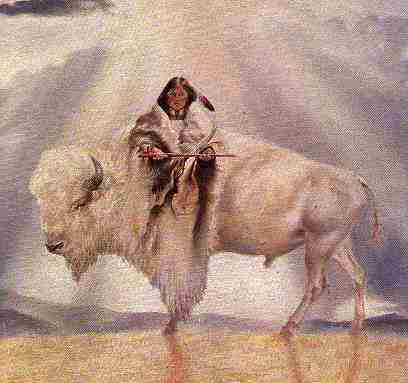
To the Native Americans the birth of a white buffalo is a symbol of rebirth and world harmony
One summer, long ago, the seven sacred council fires of the Lakota Oyate, the nation, came together and camped. Every day they sent scouts to look for game, but the scouts found nothing, and the people were starving.
Among the bands assembled were the Itazipcho, the Without-Bows, who had their own camp circle under their chief, Standing Hollow Horn. Early one morning the chief sent two of his young men to hunt for game. They searched everywhere but could find nothing. Seeing a high hill, they decided to climb it in order to look over the whole country. Halfway up, they saw something coming toward them from far off, but the figure was floating instead of walking. From this they knew that the person was wakan, holy.
At first they could make out only a small moving speck and had to squint to see that it was a human form. But as it came nearer, they realized that it was a beautiful young woman, more beautiful than any they had ever seen. She wore a wonderful white buckskin outfit, tanned until it shone a long way in the sun. It was embroidered with sacred and marvelous designs of porcupine quill, in radiant colors no ordinary woman could have made. This wakan stranger was Ptesan-Wi, White Buffalo Calf Woman. In her hands she carried a large bundle and a fan of sage leaves. She wore her hair loose except for a strand at the left side, which was tied up with buffalo fur. Her eyes shone dark and sparkling, with great power in them.
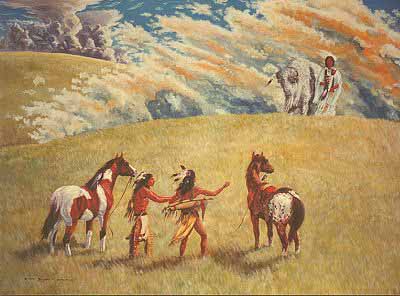
The two young men looked at her open-mouthed. One was overawed, but the other desired her and stretched his hand out to touch her. This woman was Lila wakan, very sacred, and could not be treated with disrespect. Lightning instantly struck the brash young man and burned him up, so that only a small heap of blackened bones was left.
To the other scout who had behaved rightly, the White Buffalo Calf Woman said: "Good things I am bringing, something holy to your nation. A message I carry for your people from the buffalo nation. Go back to the camp and tell the people to prepare for my arrival. Tell your chief to put up a medicine lodge with twenty-four poles. Let it be made holy for my coming."
This young hunter returned to the camp. He told the chief, and the people, what the sacred woman had commanded. So the people put up the big medicine tipi and waited. After four days they saw the White Buffalo Calf Woman approaching, carrying her bundle before her. Her wonderful white buckskin dress shone from afar. The chief, Standing Hollow Horn, invited her to enter the medicine lodge. She went in and circled the interior sunrise. The chief addressed her respectfully, saying: "Sister, we are glad you have come to instruct us."
She told him what she wanted done. In the center of the tipi they were to put up an owanka wakan, a sacred altar, made of red earth, with a buffalo skull and a three-stick rack for a holy thing she was bringing. They did what she directed, and she traced a design with her finger on the smoothed earth of the altar. She showed them how to do all this, then circled the lodge again sunwise. Halting before the chief, she now opened the bundle. The holy thing it contained was the chanunpa, the sacred pipe. She held it out to the people and let them look at it. She was grasping the stem with her right hand and the bowl with her left, and thus the pipe has been held ever since.
Again the chief spoke, saying: "Sister, we are glad. We have had no meat for some time. All we can give you is water." They dipped some wacanga, sweet grass, into a skin bag of water and gave it to her, and to this day the people dip sweet grass or an eagle wing in water and sprinkle it on a person to be purified.
The White Buffalo Calf Woman showed the people how to use the pipe. She filled it with chan-shasha, red willow-bark tobacco. She walked around the lodge four times after the manner of Anpetu-Wi, the great sun. This represented the circle without end, the sacred hoop, the road of life. The woman placed a dry buffalo chip on the fire and lit the pipe with it. This was peta-owihankeshni, the fire without end, the flame to be passed on from generation to generation.
She told them that the smoke rising from the bowl was Tunkashila's breath, the living breath of the great Grandfather Mystery.
The White Buffalo Calf Woman showed the people the right way to pray, the right words and the right gestures. She taught them how to sing the pipe-filling song and how to lift the pipe up to the sky, toward Grandfather, and down toward Grandmother Earth, to Unci, and then to the four directions of the universe.
"With this holy pipe," she said, "you will walk like a living prayer. With your feet resting upon the earth and the pipe stem reaching into the sky, your body forms a living bridge between the Sacred Beneath and the Sacred Above. Wakan Tanka smiles upon us, because now we are as one: earth, sky, all living things, the two-legged, the four-legged, the winged ones, the trees, the grasses.
Together with the people, they are all related, one family. The pipe holds them all together.
"Look at this bowl," said the White Buffalo Calf Woman. "Its stone represents the buffalo, but also the flesh and blood of the red man. The buffalo represents the universe and the four directions, because he stands on four legs, for the four ages of creation. The buffalo was put in the west by Wakan Tanka at the making of the world, to hold back the waters.
Every year he loses one hair, and in every one of the four ages he loses a leg. The sacred hoop will end when all the hair and legs of the great buffalo are gone, and the water comes back to cover Mother Earth.
The wooden stem of this chanunpa stands for all that grows on the Earth. Twelve feathers hanging from where the stem - the backbone - joins the bowl - the skull - are from Wanblee Galeshka, the spotted eagle, the very sacred bird who is the Great Spirit's messenger and the wisest of all flying ones.
You are joined to all things of the universe, for they all cry out to Tunkashila. Look at the bowl: engraved in it are seven circles of various sizes. They stand for the seven sacred ceremonies you will practice with this pipe, and for the Oceti Shakowin, the seven sacred campfires of our Lakota nation."
The White Buffalo Calf Woman then spoke to the women, telling them that it was the work of their hands and the fruit of their bodies which kept the people alive. "You are from Mother Earth," she told them. "What you are doing is as great as what the warriors do."
And therefore the sacred pipe is also something that binds men and women together in a circle of love. It is the one holy object in the making of which both men and women have a hand.
The men carve the bowl and make the stem; the women decorate it with bands of colored porcupine quills. When a man takes a wife, they both hold the pipe at the same time and red trade cloth is wound around their hands, thus tying them together for life.
The White Buffalo Calf Woman also talked to the children, because they have an understanding beyond their years. She told them that what their fathers and mothers did was for them, that their parents could remember being little once, and that they, the children, would grow up to have little ones of their own.
She told them: "You are the coming generation, that's why you are the most important and precious ones. Some day you will hold this pipe and smoke it. Some day you will pray with it."
She spoke once more to all the people: "The pipe is alive; it is a red being showing you a red life and a red road. And this is the first ceremony for which you will use the pipe. You will use it to keep the soul of a dead person, because through it you can talk to Wakan Tanka, the Great Mysterious. The day a human dies is always a sacred day. The day when the soul is released to the Great Spirit is another."
She spoke one last time to Standing Hollow Horn, the chief, saying, "Remember: this pipe is very sacred. Respect it and it will take you to the end of the road. The four ages of creation are in me. I will come to see you in every generation cycle. I shall come back to you."
The sacred woman then took leave of the people, saying: "Toksha ake wacinyanktin ktelo -- I shall see you again."
The people saw her walking off in the same direction from which she had come, outlined against the red ball of the setting sun. As she went, she stopped and rolled over four times. The first time, she turned into a black buffalo; the second into a brown one; the third into a red one; and finally, the fourth time she rolled over, she turned into a white buffalo calf. A white buffalo is the most sacred living thing you could ever encounter.
The White Buffalo Calf Woman disappeared over the horizon. As soon as she had vanished, buffalo in great herds appeared, allowing themselves to be killed so that the people might survive. And from that day on, our relations, the buffalo, furnished the people with everything they need -- meat for their food, skins for their clothes and tipi1s, and bones for their many tools.
Red Heifer in Judiasm
In Judaism, the red heifer (Hebrew parah adumah) is a heifer that is sacrificed and whose ashes are used for the ritual purification of people who came into contact with a corpse. A heifer is a young cow before she has had her first calf.
In the Bible: According to Numbers 19:2: Speak unto the Children of Israel that they bring thee a red heifer without spot, wherein is no blemish, and upon which never came yoke. The animals will not have hairs of any other color, it must be in perfect health, and it must never have been used to perform work. The cow is then brought to an altar built to the east of the Temple Mount, where it is slaughtered and burned. Cedar wood, hyssop, and scarlet are added to the fire, and the remaining ash is placed in a vessel containing pure water. In order to purify a person who has become ritually contaminated by contact with a corpse, water from the vessel is sprinkled on him, using a bunch of hyssop, on the third and seventh day after the contamination took place (Numbers 19:19). The priests who have performed the ritual then become impure themselves. Continued Wikipedia
Red Heifer Born in Israel
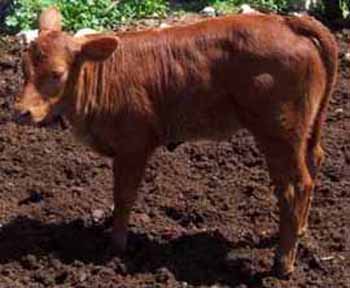
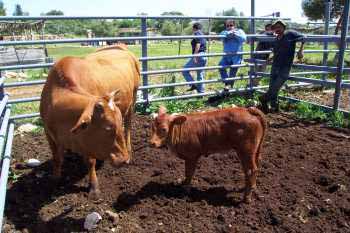
- March 2002 - a red heifer was born in Israel. The heifer's owner contacted the Temple Institute on Friday, April 5th, 2002. Rabbi Menachem Makover and Rabbi Chaim Richman traveled to the farm where the heifer lives to inspect and validate her status. The rabbis found her to be kosher and were satisfied that this heifer could indeed be a candidate to be used in the process of purification described in the book of Numbers, chapter 19. This is a prerequisite for the rebuilding of the Holy Temple. Tradition records that a red heifer in our generation is a herald of the Messianic era. It is certainly an important development towards the rebuilding of the Holy Temple. Our sages taught that Israel's redemption can be compared to the dawn. "In the beginning, it progresses very slowly...but as it continues, it grows brighter and brighter."
Other White Animals
Norway: White moose sparks debate Aftenposten - October 6, 2006
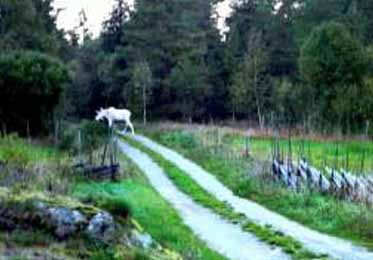
The striking sight of a white moose in the forests of Ostfold prompted a call for protection as the hunting season nears, but experts insisted the animal be shot. The moose hunting season starts on Thursday, and hunting parties in the Ostfold area where the rare albino moose has been sighted have asked that the animal be protected. Jon Arnemo, professor at the Norwegian School of Veterinary Science (NVH), said that the albino moose was a rarity, though not a sensation.
It is estimated that there are about 450,000 moose in Scandinavia, of which about a third are shot every year. There are usually reports of one white moose every year. These animals are rarely very old. Their lack of pigmentation makes them more exposed to predators like wolves and they often have inferior sight or hearing. It was not yet certain that the sighted moose was a genuine albino, with a total lack of pigment and red eye, or a 'common' moose without pigmentation.
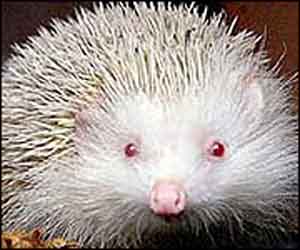
Rare White Giraffe Photographed in Tanzia, Africa National Geographic - September 9, 2005
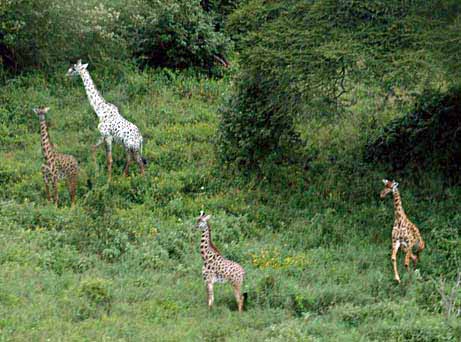
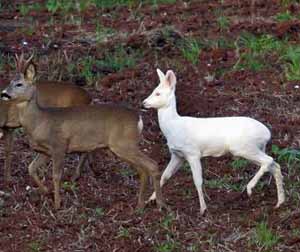
White Deer - Persian Fallow Deer - Prophecy - July 8, 2005
Rare Albino elephant spotted in Sri Lanka Nature - August 24, 2004
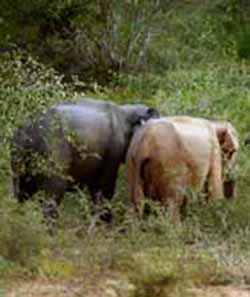
ALPHABETICAL INDEX OF ALL FILES
No comments:
Post a Comment